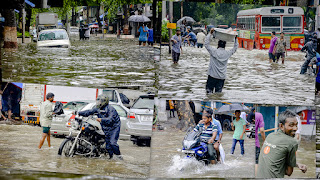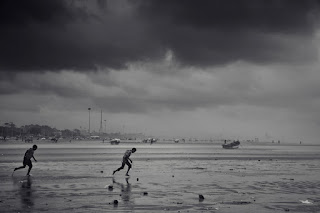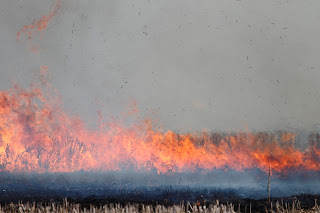Pain of Slum Dwellers in Monsoon Months: Pre-Monsoon Preparedness by National Capital Delhi and Financial Capital Mumbai for Monsoon 2022: IMD Reports
The Southwest and the Northeast monsoons influence the climate in the Indian subcontinent. Rainfall is considered as the main parameter in a hydrological cycle affecting the socio-economic well-being of a region correlating with rainfall intensity, and spatial and temporal distribution. The Southwest monsoon rainfall trend is gradually decreasing for West Bengal, west Uttar Pradesh, Jammu and Kashmir, Goa, Madhya Pradesh, Maharashtra, coastal Andhra Pradesh, Jharkhand, and Chhattisgarh, whereas the North Karnataka showed a significant increasing trend. The rainfall over these areas is decreasing in June, July, and September and is increasing in August.
In Mumbai, a seasonal rainfall of 3679.8 mm was reported by the India
Meteorological Department for the year 2020 between June to September which was
higher than the rainfall of 3670.4 mm in 2019. The highest monsoon rainfall was
reported as 3759.7 mm in 1958. In the year, 2021, Mumbai witnessed rainfall of
around 92 mm in December as a non-seasonal cyclonic storm and received rainfall
of around 3000 mm as the monsoon rainfall. As per the report of the Regional Meteorological
Centre, Monsoon started in Mumbai with a pre-monsoon shower and wind flow rate
of 40-50 kmph and will continue up to 16th June 2022. As per the
weather forecast agencies, Mumbai will be witnessing more than 22 rainy days
from June to September 2022 in each of the months.
Delhi reported a gauge rainfall of 404.3 mm in 2019, 576. 5 mm in
2020, and recorded rainfall of around 1502.8 mm in 2021 which was the highest in
the last 77 years as per IMD. The experts concluded that the 2021 monsoon was
the second wettest monsoon in Delhi after 1933 with 1534.3 mm of rainfall. As
per IMD and Regional Meteorological Centre, Monsoon will be about to hit Delhi
by the mid of June 2022 with light rain, thunderstorms, and wind speed of 25-35
kmph.
Dharavi, Mumbai in Monsoon
The slum is considered the biggest slum in India. According to the
Municipal Corporation of Greater Mumbai (MCGM), the inhabitants migrated to these
low-lying marshy-mangrove forests below 30-35 years from Bihar and Uttar
Pradesh. The low-lying settlement area of about 2-3 feet below the main road is
prone to flood. Around 5 to 6 ft of water inside the houses were observed
during the monsoon months. The slums of Mumbai cover around 8-9% of total
Mumbai. The population is around 40% of Mumbai’s population.
During the year 2020-2021, the inhabitants of the slum have witnessed the
worst monsoon with high COVID-19 infection cases. The pandemic made the
congested narrow lane slum more vulnerable as the sanitation and social
distancing were harder to maintain during monsoon. The authorities had taken a
backseat to the pre-monsoon preparations. The campaigns mostly included
awareness, self-preparation, unclogging stormwater, sludge removal, and preventing
flooding. The monsoon months of 20-21 caused the rainy season at its peak with
torrential rainfall and flooding in low-lying slum areas which led to 5-6 feet
of contaminated water, sewers overflow, garbage piles up, and made a perfect
breeding season for malaria and dengue mosquitoes.
In June 2022, the temporary bridge at Dadar-Dharavi nullah has been constructed as a pre-monsoon preparedness by Brihanmumbai Municipal Corporation (BMC) for the light motor vehicles. In addition, Mumbaikars are witnessing sludge removal and culvert cleaning in low-lying slum areas by BMC. National disaster response Force (NDRF) and the National Disaster Management Authorities (NDMA) have planned to deploy the teams of the Navy, Army, and Coast guard to Mumbai.
To fight flash floods, dewatering pumps at pumping stations and trash
boom barriers are being ready as a mitigation measure. Manholes flags and
banners will be put as a caution to the prevention of any unexpected accidents.
Delhi Slums in Monsoon
The largest slum, Lalbagh in Delhi was having a population of more than 3
Lakhs and is spreading over a small distance of one kilometer only. Not only the
Lalbagh slum, but Delhi also has almost 31 notified and un-notified slums in
and around. The government acknowledged the allotment of public land, sanitation
measures, construction of water drainage systems, community-built toilet blocks,
and food supply in notified slum areas only. The notified and un-notified Delhi
slum areas are clumsy with lined-up homes, and wrongly built and mismanaged
water supply systems causing water clogging and mixing with sewage in monsoon. Slum-dwellers
were affected as water seeps into the houses making knee-high water clogging houses
and toilets. The main problem is the unplanned construction that chokes the
stormwater drains which carry a large volume of water. Monsoon became tougher for
these people with growing diseases like dengue and malaria. Not only slums but
Delhi was also affected highly due to chronic drainage problems on roads and
under the bridges in the year 20-21. The massive waterlogging and traffic
disruptions with gusty winds challenged the Traffic department.
Despite the situation, Govt claimed 16.19% of slums had planned nallah drain,
and 54.91% of slums are of composed concrete pucca structures, 29.47% semi
constructed structures, and only 15.62% of slum areas are with Katcha houses.
The major source of drinking and domestic water is being supplied to around
86.50% of slum people and 30% of the slum population are using a septic tank with
flush-type toilets. About 98% of slums are having underground and covered concrete
drainage systems. In addition, Govt also claimed that 48% of slum areas are
having pucca-kutcha roads for motor vehicles and 77% of slums have a concrete
lane with the colonies of a slum and only 9.3% of the slums were usually got waterlogged
during the rainy season.
On another hand, New Delhi Municipal Corporation (NDMC) and Public Works
Departments are getting ready for the 2022 monsoon with 300 house workers to
deal with the water-logging issues during heavy rain hours. The corporation has
completed 96% of the drain by removing 87,000 metric tonnes of sludge from 668
drains and the remaining will be completed before the arrival of the monsoon to
Delhi and identified 12,000 possible water logging lock points. The National
Disaster Response Force (NDRF) has trained 12 disaster management centers to manage
the blockage of roads due to trunks and tree uprooting. The pumping systems are
installed in storm drains to prevent clogging in locations like Minto Bridge. Several
agencies such as PWD, Delhi State Industrial Infrastructure Development Corporation
Ltd (DSCIIDC), and Irrigation and Flood Control Department of Delhi along with
Quick Response Teams formed a venture to work with coordination. According to a
survey of some agencies, the waterlogging rate was decreasing exponentially in the
last 5 years.


















